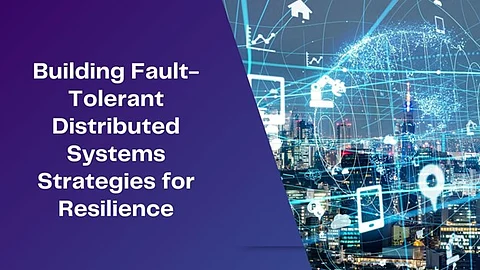

In the age of technology today, distributed systems drive everything from business-critical applications to run-of-the-mill digital services. As such networks become more complex, having them be reliable is paramount. Vedant Agarwal's research on fault tolerance provides methodologies—such as replication, consensus protocols, and automatic recovery—central to the construction of dependable, fault-resistant systems.
Distributed systems run across numerous nodes and are susceptible to failures that could compromise data and service availability. Analysis indicates that "partial failures" (when some parts fail while others remain operational) are the cause of 47% of outages. In the absence of robust fault tolerance, these types of failures can become very serious very fast. For instance, systems lacking sophisticated monitoring could take as much as 67 minutes to detect consistency issues, whereas those with automatic detection cut this down to a mere 8.3 minutes. High-availability systems employing these methods have attained 99.995% uptime—just 26.28 minutes of downtime in a year—and reduce catastrophic failure by as much as 82%.
Replication is a fundamental fault-tolerant technique where multiple copies of data are maintained across nodes. Research indicates that multi-node replication can attain 99.997% durability, significantly higher than the approximately 99.92% durability of single-node systems. Some major models are:
● Synchronous Replication: Ensures that every copy of the data is exact in real-time, providing strong consistency but some delay.
● Asynchronous Replication: Lowers delay by about 73%, though brief consistency lags may occur.
● Quorum-Based Replication: Balances consistency and speed to reduce downtime.
Selecting the right replication strategy helps optimize performance while keeping data safe and available.
To make distributed systems operate reliably, every node needs to agree on the same state—like team members coming to a consensus. Consensus protocols make this possible even in the presence of failures. For instance, Paxos-based systems can obtain consensus in roughly 23.8 milliseconds at a 99.98% success rate. Some of the important protocols are:
● Classic Paxos: Handles up to 18,500 operations per second with a latency of 28.5 milliseconds.
● Multi-Paxos: Boosts throughput by 3.2 times, processing up to 59,200 operations per second.
● Raft Consensus: Known for simplicity, it elects a leader in 98 milliseconds, even amid network issues.
These protocols also reduce “split-brain” scenarios by up to 91%, greatly improving reliability.
Quick detection and repair of faults are essential to reducing downtime. In cloud environments, heartbeat-based monitoring can identify node failures in approximately 3.1 seconds with a very low false alarm rate (0.028%). Recovery methods further improve resilience:
● Checkpoint-Based Recovery: Saves snapshots of the system, cutting recovery time from 147 minutes to 42 seconds.
● Log-Based Recovery: Maintains data integrity with consistency rates near 100%.
● Self-Healing Systems: AI-driven tools can predict failures up to 22 minutes in advance, enabling proactive fixes.
Together, these methods help ensure smooth, continuous operations.
Artificial intelligence is transforming fault tolerance with real-time anomaly detection and predictive analytics. AI-driven platforms analyze around 18,500 data points per second with 99.98% accuracy, offering up to 22 minutes’ warning of potential issues. Benefits include:
● Automated Response: Rapidly addresses issues, reducing recovery time by up to 71.3%.
● Chaos Engineering: Regular stress tests have been shown to improve resilience by 88%.
● Intelligent Load Balancing: AI systems dynamically adjust workloads, reducing bottlenecks by up to 42%.
These AI-powered solutions not only boost reliability but also lower operational costs.
Fault tolerance is being revolutionized by artificial intelligence through real-time anomaly detection and predictive analytics. AI-powered platforms scan approximately 18,500 data points per second with 99.98% accuracy and provide up to 22 minutes' notice of impending problems. Advantages are:
● Round Robin: Equally distributes requests, though it ignores individual server capacity.
● Weighted Load Balancing: Routes tasks based on server strength, reducing overload by up to 56%.
● AI-Driven Load Balancing: Uses real-time data to optimize resource allocation and response times.
These methods help avoid bottlenecks and sustain high performance.
Emerging trends promise to further advance fault tolerance:
● Self-Healing Architectures: Systems that automatically detect and resolve issues.
● Flexible Consensus Protocols: New models like Flexible Paxos and EPaxos aim to improve speed and efficiency.
● Blockchain for Fault Tolerance: Decentralized approaches enhance reliability and security.
● Serverless Computing: Simplifies failure management by automatically scaling resources without traditional infrastructure complexities.
While the demand for resilient, scalable distributed systems increases, sophisticated fault tolerance techniques become essential. Through optimized replication, advanced consensus protocols, fast failure detection, and AI-based recovery, organizations can reduce downtime and maintain data consistency. Vedant Agarwal's research demonstrates how these innovations are transforming distributed architecture and setting the stage for an resilient digital future. Adopting these innovations will enhance efficiency and provide high availability in an increasingly complex computing environment.
